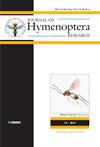The genome of the egg parasitoid Trissolcus basalis (Wollaston) (Hymenoptera, Scelionidae), a model organism and biocontrol agent of stink bugs
IF 1.4
3区 农林科学
Q2 ENTOMOLOGY
引用次数: 0
Abstract
Trissolcus basalis (Wollaston) is a minute parasitic wasp that develops in the eggs of stink bugs. Over the past 30 years, Tr. basalis has become a model organism for studying host finding, patch defense behavior, and chemical ecology. As an entry point to better understand the molecular basis of these factors, in addition to filling a critical gap in the genomic resources available for parasitic Hymenoptera, we sequenced and assembled the genome of Tr. basalis using short (454, Illumina) and long read (Oxford Nanopore) sequencing technologies. The three sequencing methods produced 32 million reads (4.10 Gb; 27.9×), which were assembled into 7,586 scaffolds. The 147 Mb (N50: 42.8 kb) assembly contains complete sequences for 93.1% of the insect BUSCO dataset, and an extensive annotation protocol resulted in 14,158 protein-coding gene models, 12,197 (86%) of which had a blast hit in GenBank. Repetitive elements comprised 13.8% of the genome, and a phylogenomic analysis recovered Tr. basalis as sister to Chalcidoidea, a result in line with other studies. We identified 174 rapidly evolving gene families in Tr. basalis, including olfactory receptors and pheromone/general odorant binding proteins. These genetic elements are an obligatory portion of the parasitoid-host relationship, and the draft genome of Tr. basalis has and will continue to be useful in elucidating these relationships at finer resolution.卵寄生蜂Trisolcus basalis(Wollaston)(膜翅目,锥虫科)的基因组研究
三尾寄生蜂是一种微小的寄生蜂,在臭虫的卵中发育。在过去的30年里,褐毛霉已经成为研究寄主寻找、斑块防御行为和化学生态学的模式生物。为了更好地了解这些因素的分子基础,除了填补可用于寄生性膜翅目昆虫的基因组资源的关键空白之外,我们还使用短(454,Illumina)和长(Oxford Nanopore)测序技术对Tr. basalis的基因组进行了测序和组装。三种测序方法共产生3200万个reads (4.10 Gb;27.9×),组装成7586个支架。147 Mb (N50: 42.8 kb)的汇编包含93.1%的昆虫BUSCO数据集的完整序列,广泛的注释协议产生14,158个蛋白质编码基因模型,其中12,197个(86%)在GenBank中获得blast hit。重复元素占基因组的13.8%,系统基因组分析发现Tr. basalis是Chalcidoidea的姐妹,结果与其他研究一致。我们鉴定出了174个快速进化的基因家族,包括嗅觉受体和信息素/一般气味结合蛋白。这些遗传元素是寄主-寄主关系的必要组成部分,基底褐毛霉的基因组草图已经并将继续有助于在更精细的分辨率上阐明这些关系。
本文章由计算机程序翻译,如有差异,请以英文原文为准。
求助全文
约1分钟内获得全文
求助全文
来源期刊
CiteScore
2.60
自引率
15.40%
发文量
68
审稿时长
>12 weeks
期刊介绍:
The Journal of Hymenoptera Research is a peer-reviewed, open-access, rapid online journal launched to accelerate research on all aspects of Hymenoptera, including biology, behavior, ecology, systematics, taxonomy, genetics, and morphology.
All published papers can be freely copied, downloaded, printed and distributed at no charge for the reader. Authors are thus encouraged to post the pdf files of published papers on their homepages or elsewhere to expedite distribution. There is no charge for color.

 求助内容:
求助内容: 应助结果提醒方式:
应助结果提醒方式:


